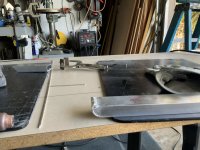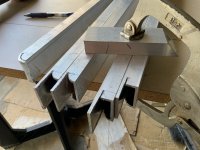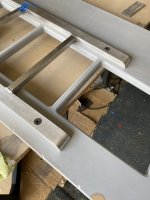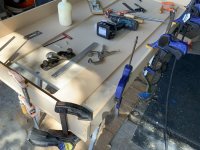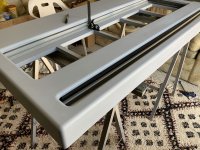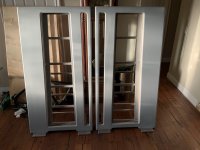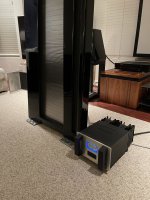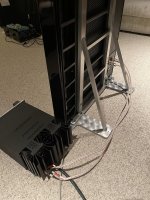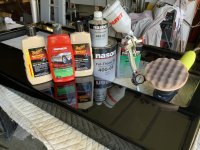Hey everyone
Nice to see some activity here again.
I have progressed here, slowly but surely.
For Apogee-style bass panels, the plans and drawings are now complete.
Membranes have been completed. Only the hardest part is ahead. the workshop needs to be cleaned.
.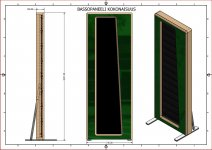
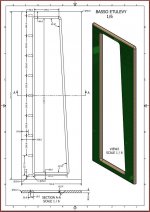
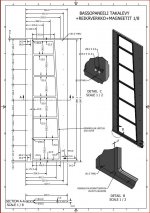
The buddy of this bass panel will be the midrange treble tower.
This is also under construction.
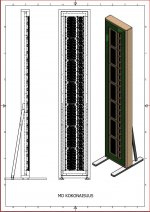
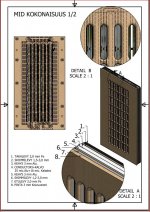
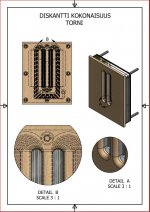
Nice to see some activity here again.
I have progressed here, slowly but surely.
For Apogee-style bass panels, the plans and drawings are now complete.
Membranes have been completed. Only the hardest part is ahead. the workshop needs to be cleaned.
.



The buddy of this bass panel will be the midrange treble tower.
This is also under construction.



Last edited:
Why abandon the trapezoidal shape of the frame? That's an iconic shape.
So, these are not simply Apogee copies since there are multiple mid/tw drivers. Is this arrangement proposed to be much better than the original? Or, did you simply decide to go that route just to see if you can do it (which is certainly admirable)?
I would think keeping the original technology and improving it where needed would be easier. For example, using a butyl (or similar) surroung for the bass panel so it's serviceable in the future. Analysis Audio does that with some advantages, lack of resonances and tuning ease being two of them.
So, these are not simply Apogee copies since there are multiple mid/tw drivers. Is this arrangement proposed to be much better than the original? Or, did you simply decide to go that route just to see if you can do it (which is certainly admirable)?
I would think keeping the original technology and improving it where needed would be easier. For example, using a butyl (or similar) surroung for the bass panel so it's serviceable in the future. Analysis Audio does that with some advantages, lack of resonances and tuning ease being two of them.
New covers with 2K primer and eagle eyes will notice I reduced the width
on the bass side by 1” as it was overkill IMO and never occurred in later models
no consequences in tuning
on the bass side by 1” as it was overkill IMO and never occurred in later models
no consequences in tuning
Attachments
Quite the project and tons of work but Scintillas are worth the effort overall !
currently using a Sunfire 300 with a protection limit modification
top to bottom coherence and unrestrained dynamic flow is amazing
The old tacked on outside series bass foil was remade and placed inside
currently using a Sunfire 300 with a protection limit modification
top to bottom coherence and unrestrained dynamic flow is amazing
The old tacked on outside series bass foil was remade and placed inside
Attachments
Last edited:
@Studley I researched everything for several months before taking my Duetta II Signatures to Music Technology in VA about a month ago (after being on a waiting list queue for 2 years!). This shop (Bill Thalmann) and True Sound Works (Rich Murray) in NV are the only shops I would have my Apogees restored/upgraded. They are the only shops in the US that Graz has authorized and trained to install his Apogee ribbons (he’s based in Australia). People that discount the quality of his product and work either have agendas or they aren’t educated on the subject and simply spout their opinions with zero evidence. You get what you pay for. Rich does offer stronger magnet upgrades, but Bill does not. I decided not to mess with the magnets because now you are profoundly changing the speaker because the magnet fields have been altered. Greater efficiency would be nice, but not worth it in my opinion. One must ask yourself do you have greatly trust in aftermarket alterations by people that had no involvement with designing these special line of speakers (and lack the depth of knowledge of NASA engineers that designed Apogee speakers)? I certainly don’t. With a hybrid Apogee speaker the impact would likely be less profound, but I didn’t do my research and have innumerable conversations with experts based on anything but the full range ribbon Apogee speakers. Feel free to reach out to me directly. I can share a LOT of other very important information that isn’t appropriate for a public forum. Which model in particular are you asking about?
@parker65310; I’m thinking about either DIvas or possibly Scinnies. I’m in the UK and Jon will be doing my rebuild 😀. I will be discussing magnet options with him but it doesn’t harm to get more opinions. I‘ll PM you.
Well, the laws of physics suggest that if everything else is equal, stronger magnets will increase sensitivity. I guess there may be some effect on impedance, but I can't see that it would be very significant. The construction of the ribbon will pretty much determine the impedance, I think.
Having said that, if you consider a conventional driver, increasing magnet strength will increase BL, which will reduce Qes, and alter the response shape. The increase in midrange sensitivity may not be matched in the bass. Will something similar happen with a ribbon/planar? I have no idea. I'd like to know too.
Having said that, if you consider a conventional driver, increasing magnet strength will increase BL, which will reduce Qes, and alter the response shape. The increase in midrange sensitivity may not be matched in the bass. Will something similar happen with a ribbon/planar? I have no idea. I'd like to know too.
Q1: Yes, Maxwell says that force (ie sensitivity) is proportional to the magnetic field (gauss), length of the conductor and to the electric current applied. Double the magnetic field and get twice the driving force for the same applied current.I have a question about magnets. My understanding is that if one were to use stronger magnets (eg neo) than the original Apogee magnets then it would increase the sensitivity. Can anyone confirm that to be true?
Second question; would it have any impact on the impedance?
Q2: Yes, but only slightly. Since the same current is applying twice the force to the air as before, the acoustic impedance is reflected back to the electrical impedance differently. However because a ribbon is almost a short circuit and has a very low self-shunting resistance, the reflected acoustic impedance would be swamped by this shunt resistance and would likely be negligible, except possibly at the ribbon’s primary resonance at a very low frequency.
I have owned Apogee Diva and now Full Range speakers. I ran frequency sweeps of the impedance of each driver. The woofers show their primary resonance as only a small “blip” on an otherwise ruler-flat impedance curve (which is almost entirely resistive), quite different from the huge peaks seen with cone drivers. The midrange and tweeters in these Apogees are also ruler-flat but also show the tiniest blips at amazingly low frequencies. In the Diva midrange, as I recall, it was around 16Hz! With the looser hanging midrange of the Full Range the primary resonance is at about 1/2 Hz! These upper ribbons are operating completely outside of their primary resonance regions, one of the reasons that these ribbons are so coveted.
Sounds good. Also, the replies after mine I think are spot-on with my thinking, although I’m not qualified as an engineer and don’t build my own speakers@parker65310; I’m thinking about either DIvas or possibly Scinnies. I’m in the UK and Jon will be doing my rebuild 😀. I will be discussing magnet options with him but it doesn’t harm to get more opinions. I‘ll PM you.
Brian, thanks that very informative and your comments about the impedance curve are spookily apposite; just today I started a thread in which I asked about the feasibility of a current source amp (F2J) driving a long ribbon tweeter. My understanding is that a ”driver” that has a relatively flat impedance curve is an ideal candidate for being driven by a current source amp. So your information about the flat impedance curve of the Apogee ribbons is extremely interesting and suggests that suitably powerful current source amps might be ideal for an active crossover Apogee set up.
Ah-ha! Studley, you’ve figured out what I have been planning for several years. I have sketched out a rough schematic for a current output amplifier to drive the brutal 0.19 ohm Full Range midrange ribbon. The speaker did come with very nice toroidal transformer that steps up this impedance to a manageable 13 ohms or so. But a properly-executed direct-drive connection should be better. A current output amplifier, also called a transimpedance amplifier, is happiest with a dead short on its output.
The impedance phase is almost entirely a result of the crossover network used since the drivers are almost entirely resistive. Standard drivers are much better motor structures with significantly higher inductance. (And with various resonances associated with their mechanical construction.)What is also impressive other than relatively flat impedance is the phase angles across the frequency spread.
No outrageous wild phase peaks in comparison to standard cone drivers that you can see in almost all of Stereophile test charts
In either case, decent power amplifiers would be bothered by a mildly reactive load.
Dave.
Great minds BrianAh-ha! Studley, you’ve figured out what I have been planning for several years. I have sketched out a rough schematic for a current output amplifier to drive the brutal 0.19 ohm Full Range midrange ribbon. The speaker did come with very nice toroidal transformer that steps up this impedance to a manageable 13 ohms or so. But a properly-executed direct-drive connection should be better. A current output amplifier, also called a transimpedance amplifier, is happiest with a dead short on its output.
That would be this guy? https://www.diyaudio.com/community/threads/the-end-of-a-era-and-ewa-designs-for-sale.345773/I am friends with a genius (and I use word literally) amp designer, Colin Wonfor.
- Home
- Loudspeakers
- Planars & Exotics
- Anyone making Apogee bass panels?
